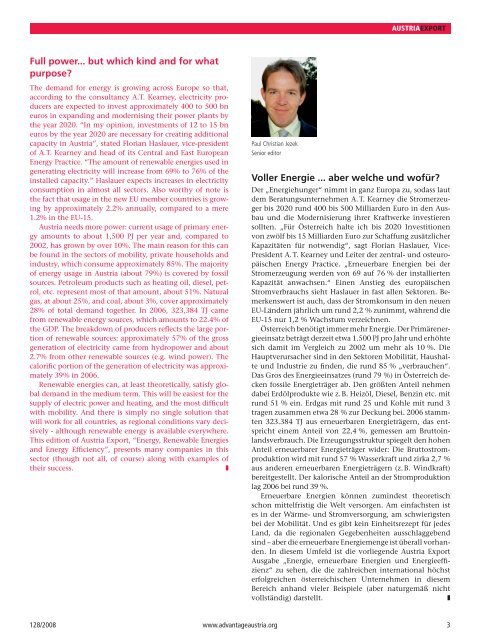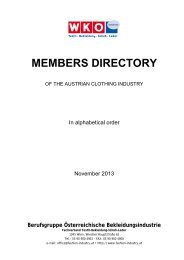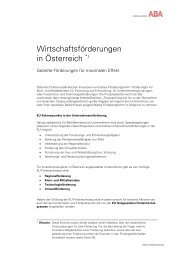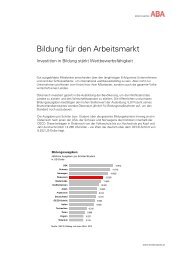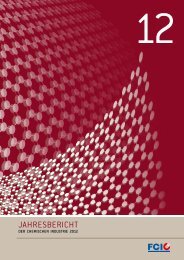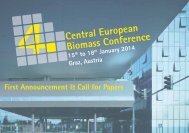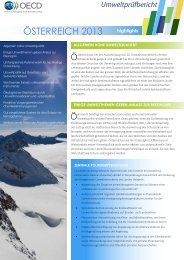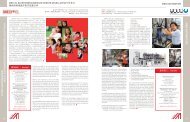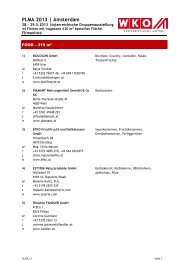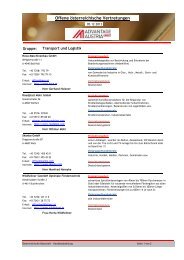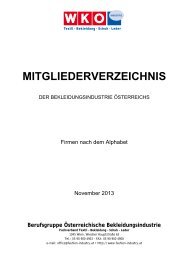Energie, erneuerbare Energien und ... - Advantageaustria.org
Energie, erneuerbare Energien und ... - Advantageaustria.org
Energie, erneuerbare Energien und ... - Advantageaustria.org
You also want an ePaper? Increase the reach of your titles
YUMPU automatically turns print PDFs into web optimized ePapers that Google loves.
Full power... but which kind and for what<br />
purpose?<br />
The demand for energy is growing across Europe so that,<br />
according to the consultancy A.T. Kearney, electricity producers<br />
are expected to invest approximately 400 to 500 bn<br />
euros in expanding and modernising their power plants by<br />
the year 2020. “In my opinion, investments of 12 to 15 bn<br />
euros by the year 2020 are necessary for creating additional<br />
capacity in Austria”, stated Florian Haslauer, vice-president<br />
of A.T. Kearney and head of its Central and East European<br />
Energy Practice. “The amount of renewable energies used in<br />
generating electricity will increase from 69% to 76% of the<br />
installed capacity.” Haslauer expects increases in electricity<br />
consumption in almost all sectors. Also worthy of note is<br />
the fact that usage in the new EU member countries is growing<br />
by approximately 2.2% annually, compared to a mere<br />
1.2% in the EU-15.<br />
Austria needs more power: current usage of primary energy<br />
amounts to about 1,500 PJ per year and, compared to<br />
2002, has grown by over 10%. The main reason for this can<br />
be fo<strong>und</strong> in the sectors of mobility, private households and<br />
industry, which consume approximately 85%. The majority<br />
of energy usage in Austria (about 79%) is cov ered by fossil<br />
sources. Petroleum products such as heating oil, diesel, petrol,<br />
etc. represent most of that amount, about 51%. Natural<br />
gas, at about 25%, and coal, about 3%, cover approximately<br />
28% of total demand together. In 2006, 323,384 TJ came<br />
from renewable energy sources, which amounts to 22.4% of<br />
the GDP. The breakdown of producers refl ects the large portion<br />
of renewable sources: approximately 57% of the gross<br />
generation of electricity came from hydropower and about<br />
2.7% from other renewable sources (e.g. wind power). The<br />
calorifi c portion of the generation of electricity was approximately<br />
39% in 2006.<br />
Renewable energies can, at least theoretically, satisfy global<br />
demand in the medium term. This will be easiest for the<br />
supply of electric power and heating, and the most diffi cult<br />
with mobility. And there is simply no single solution that<br />
will work for all countries, as regional conditions vary decisively<br />
- although renewable energy is available everywhere.<br />
This edition of Austria Export, “Energy, Renewable <strong>Energie</strong>s<br />
and Energy Effi ciency”, presents many companies in this<br />
sector (though not all, of course) along with examples of<br />
their success. ❚<br />
Paul Christian Jezek<br />
Senior editor<br />
AUSTRIAEXPORT<br />
Voller <strong>Energie</strong> ... aber welche <strong>und</strong> wofür?<br />
Der „<strong>Energie</strong>hunger“ nimmt in ganz Europa zu, sodass laut<br />
dem Beratungsunternehmen A. T. Kearney die Stromer zeuger<br />
bis 2020 r<strong>und</strong> 400 bis 500 Milliarden Euro in den Ausbau<br />
<strong>und</strong> die Modernisierung ihrer Kraftwerke investieren<br />
sollten. „Für Österreich halte ich bis 2020 Investitionen<br />
von zwölf bis 15 Milliarden Euro zur Schaffung zusätzlicher<br />
Kapazitäten für notwendig“, sagt Florian Haslauer, Vice-<br />
President A. T. Kear ney <strong>und</strong> Leiter der zentral- <strong>und</strong> osteuropäischen<br />
Energy Practice. „Erneuerbare <strong>Energie</strong>n bei der<br />
Stromerzeugung werden von 69 auf 76 % der installier ten<br />
Kapazität anwachsen.“ Einen Anstieg des europäischen<br />
Stromverbrauchs sieht Haslauer in fast allen Sektoren. Bemerkenswert<br />
ist auch, dass der Stromkonsum in den neuen<br />
EU-Ländern jährlich um r<strong>und</strong> 2,2 % zunimmt, während die<br />
EU-15 nur 1,2 % Wachstum verzeichnen.<br />
Österreich benötigt immer mehr <strong>Energie</strong>. Der Primärenergie<br />
einsatz beträgt derzeit etwa 1.500 PJ pro Jahr <strong>und</strong> erhöh te<br />
sich damit im Vergleich zu 2002 um mehr als 10 %. Die<br />
Hauptverursacher sind in den Sektoren Mobilität, Haus hal -<br />
te <strong>und</strong> Industrie zu fi nden, die r<strong>und</strong> 85 % „verbrau chen“.<br />
Das Gros des <strong>Energie</strong>einsatzes (r<strong>und</strong> 79 %) in Österreich decken<br />
fossile <strong>Energie</strong>träger ab. Den größten Anteil neh men<br />
dabei Erdölprodukte wie z. B. Heizöl, Diesel, Benzin etc. mit<br />
r<strong>und</strong> 51 % ein. Erdgas mit r<strong>und</strong> 25 <strong>und</strong> Kohle mit r<strong>und</strong> 3<br />
tragen zusammen etwa 28 % zur Deckung bei. 2006 stammten<br />
323.384 TJ aus erneuerba ren <strong>Energie</strong> trä gern, das entspricht<br />
einem Anteil von 22,4 %, gemes sen am Bruttoinlandsverbrauch.<br />
Die Erzeu gungs struktur spie gelt den hohen<br />
Anteil <strong>erneuerbare</strong>r <strong>Energie</strong>träger wider: Die Bruttostromproduktion<br />
wird mit r<strong>und</strong> 57 % Was ser kraft <strong>und</strong> zirka 2,7 %<br />
aus ande ren <strong>erneuerbare</strong>n <strong>Energie</strong>trägern (z. B. Windkraft)<br />
bereitgestellt. Der kalori sche Anteil an der Stromproduktion<br />
lag 2006 bei r<strong>und</strong> 39 %.<br />
Erneuerbare <strong>Energie</strong>n können zumindest theoretisch<br />
schon mittelfristig die Welt vers<strong>org</strong>en. Am einfachsten ist<br />
es in der Wärme- <strong>und</strong> Stromvers<strong>org</strong>ung, am schwierigsten<br />
bei der Mobilität. Und es gibt kein Einheitsrezept für jedes<br />
Land, da die regionalen Gegebenheiten ausschlaggebend<br />
sind – aber die <strong>erneuerbare</strong> <strong>Energie</strong>menge ist überall vorhanden.<br />
In diesem Umfeld ist die vorliegende Austria Export<br />
Ausgabe „<strong>Energie</strong>, <strong>erneuerbare</strong> <strong>Energie</strong>n <strong>und</strong> <strong>Energie</strong> effi -<br />
zienz“ zu sehen, die die zahlreichen international höchst<br />
erfolgreichen öster reichischen Unternehmen in diesem<br />
Bereich anhand vieler Beispiele (aber naturgemäß nicht<br />
vollständig) darstellt. ❚<br />
128/2008 www.advantageaustria.<strong>org</strong><br />
3


